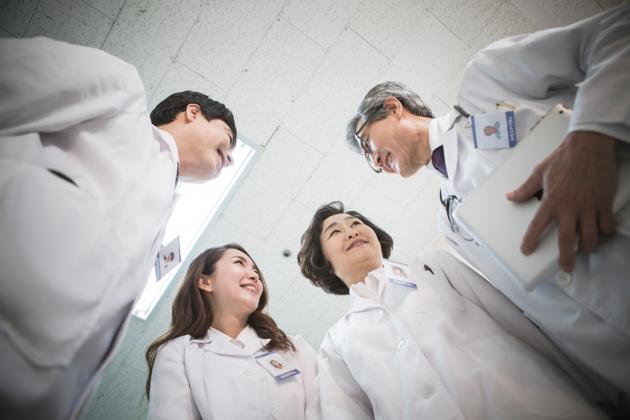
Korea’s health level, access to healthcare, hospital beds, and medical equipment are higher than the OECD average, but its numbers of clinicians and nurses are lower, according to the Ministry of Health and Welfare Tuesday.
The ministry said so based on its analysis of the Organization for Economic Cooperation and Development Health Statistics 2023.
Regarding the healthcare workforce, the number of clinical doctors, including oriental medicine practitioners, was 2.6 per 1,000 people in Korea in 2021, the second lowest among OECD countries after Mexico.
Countries with more clinical doctors per 1,000 people include Austria and Norway, with 5.4 and 5.2. Japan also had 2.6 doctors in 2020, slightly more than 2.5 in Mexico.
The number of medical school graduates in Korea, including oriental medicine, and excluding dentistry, was 7.3 per 100,000 people, the third lowest among OECD countries, after Israel’s 6.8 and Japan’s 7.2.
The nursing workforce, including nursing assistants, was 8.8 per 1,000 people here, 1.0 less than the OECD average of 9.8. There were only 4.6 nurses in Korea if nursing assistants were excluded, barely more than half of the OECD average of 8.4.
On the other hand, the number of nursing school graduates in Korea in 2021 was 43.0 per 100,000 people, way above the OECD average of 32.1.
The number of hospital beds in 2021 was 12.8 per 1,000 inhabitants, the highest among OECD countries and about 2.9 times the OECD average of 4.3. Of these, acute care beds were 7.3 per 1,000 people, more than twice the OECD average of 3.5.
Korea had 35.5 magnetic resonance imaging (MRI) machines per 1 million people and 42.2 computed tomography (CT) machines, higher than the OECD average of 19.6 MRI and 29.8 CT units.
Korea used MRIs 80.1 times per 1,000 people, lower than the OECD average, and 281.5 CT scans, the highest among OECD countries.
In healthcare services, Korea had the highest number of outpatient visits to doctors per capita, with 15.7 per year, among OECD countries, about 2.6 times higher than the average of 5.9 visits among 38 member countries of the club, mostly of wealthy nations.
The average number of hospitalized days in Korea was 18.5, second only to Japan’s 27.5 days. The OECD average was 8.1 days.
The average length of stay per hospitalized patient for acute care was 7.6 days, longer than the OECD average of 6.6 days.
Over the past decade, the average number of days per hospitalized patient in Korea has been increasing while the number of days per acute care patient has been decreasing.
Ordinary health expenditure, the total amount spent by the entire population on healthcare services and goods in a year, was 9.3 percent of gross domestic product (GDP), lower than the OECD average of 9.7 percent.
Per capita out-of-pocket health expenditure was $4,189.1 at purchasing power parity (US$PPP), increasing at an average annual rate of 8.0 percent over the past decade and higher than the OECD average of 4.4 percent. The proportion of medical expenses paid directly by households gradually decreased to 34.9 percent in 2011, 34.1 percent in 2016, and 29.1 percent in 2021.
Korea's per capita drug sales amounted to 785.3 US$PPP, 190.9 US$PPP higher than the OECD average of 594.4 US$PPP.
Among older adults 65 and more, the share of long-term care recipients in Korea was 8.1 percent at home and 2.6 percent at outside facilities, lower than the OECD average of 10.2 percent at home and 3.5 percent at facilities.
However, the share of long-term care expenditure in GDP increased from 0.5 percent in 2011 to 1.1 percent in 2021, as the number of long-term care recipients increased due to the rapid aging of the population.
Regarding long-term care beds, the total number of nursing home and long-term care facility beds per 1,000 people aged 65 and over in Korea was 57.3.
Besides, the life expectancy of Koreans was 83.6 years, higher than the OECD average of 80.3 years and ranked in the middle to high range.
In addition, the avoidable mortality rate has been declining for a long time and was 142.0 per 100,000 people, significantly lower than the OECD average of 239.1.
Obesity and overweight, a leading cause of chronic diseases for people aged 15 and older, was 36.7 percent, the second lowest among OECD countries. The OECD average is 57.5 percent.
"The OECD Health Statistics is a nationally representative statistic calculated by common standards among OECD countries, which is important for objectively analyzing and evaluating the level of healthcare in Korea and serving as a basis for business departments to plan policies,” said Kim Sun-do, an information and statistics officer at the ministry.
Kim went on to say, “We will continue to cooperate with international organizations, including OECD and World Health Organization, to expand the production of internationally comparable Korean healthcare statistics and strive to strengthen statistical quality management so that the public can actively use them in various policy areas.”

